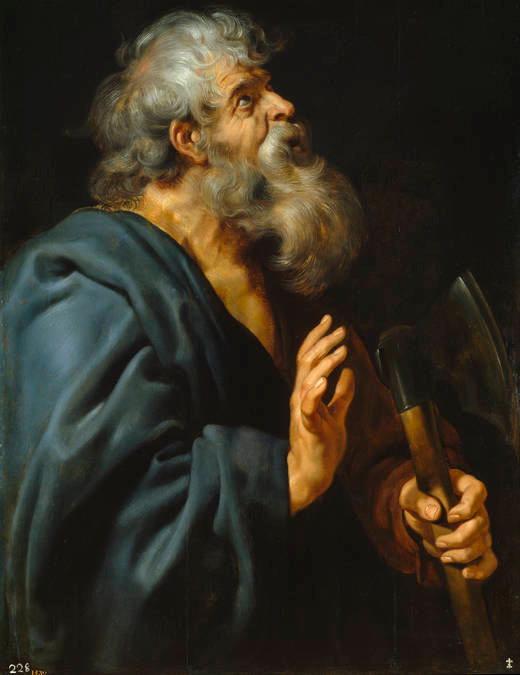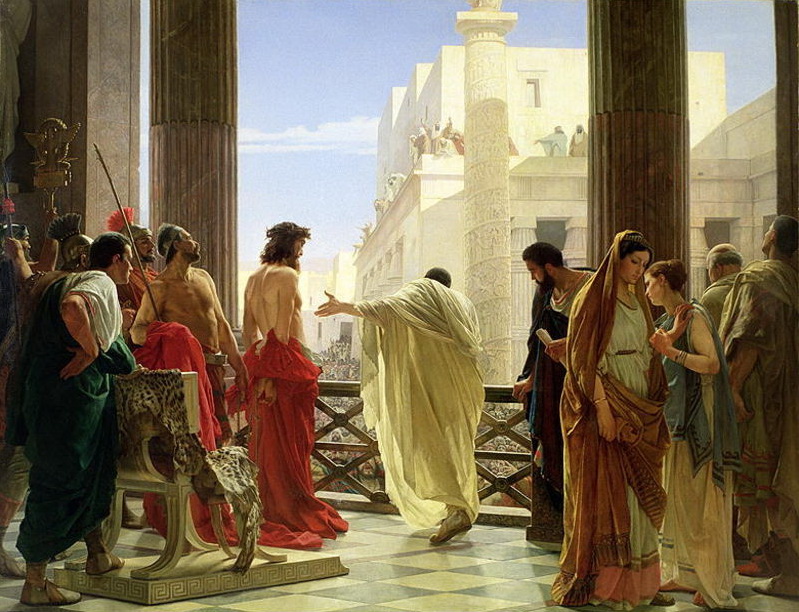
* * * *
We are still in the Season of Epiphany, running from January 6 – the day of Epiphany – to Ash Wednesday. This year Ash Wednesday comes on March 2, and it marks the beginning of Lent. But as far as Feast Days go, the next relatively major one comes on Thursday, February 24. That’s the Feast of St. Matthias, the Apostle who took the place of Judas:
…according to the Acts of the Apostles, [he] was the apostle chosen by the remaining eleven apostles to replace Judas Iscariot following Judas’ betrayal of Jesus and suicide. His calling as an apostle is unique in that his appointment was not made personally by Jesus, who had already ascended to heaven, [and] before the descent of the Holy Spirit…
See Saint Matthias – Wikipedia. Note also this St. Matthias is not to be confused with St. Matthew, the Gospel-writer whose Feast Day is September 21. I wrote about this “overlooked apostle” – not to mention unique – in February 2015’s On St. Matthias – and “Father Roberts.”
“Father Roberts” (1853-1949) was a missionary to Native American tribes including the Shoshone. But this John Roberts was different. Many Christian missionaries tried to change the culture and lifestyle of Native peoples. But Father Roberts believed it was important to preserve the language, customs, and culture of the people. Thus he tried to “honor and respect the ancient ways of the Native peoples while at the same time proclaiming the Gospel among them.” And that may be why he got his own feast day – in the Daily Office – on February 25.
There’s more on this fascinating missionary in the February 2015 post, but let’s get back to St. Matthias. His story is also fascinating. Like the fact he was also known as “Unremarkable Matthias” or the “Overlooked Apostle.” See The Overlooked Holy Apostle, Matthias. Also, Isaac Asimov gave a pithy description of how Matthias became an Apostle:
Peter arranged to have a new individual selected to take the place of Judas Iscariot in order to bring the number of the inner circle back to the mystical twelve that matched the twelve tribes of Israel. Two were nominated, Joseph Barsabbas and Matthias. To choose between the two, lots were used: Acts 1:26 … and the lot fell upon Matthias; and he was numbered with the eleven apostles. Neither Joseph Barsabbas nor Matthias are mentioned anywhere else in the New Testament.
So while we can be sure he was “numbered with the eleven,” some confusion remains about who he really was. For example, The Overlooked Holy Apostle said that “Matthias was originally Zacchaeus.” He was the tax collector Zacchaeus, who climbed a sycamore tree* because he couldn’t see Jesus, both as he was short and because of the crowd of people.
See the full story of Zacchaeus at Luke 19:1-10, and the Wikipedia article. The latter said Zacchaeus was an example “of Jesus‘s personal, earthly mission to bring salvation to the lost.” In this case, the “lost” included tax collectors, who were despised as traitors – “working for the Roman Empire, not for their Jewish community” – and for being corrupt. But Zacchaeus – after seeing Jesus – “repented of his former life after meeting the Lord.”
Getting back to St. Matthias: The article Overlooked Holy Apostle goes into great detail about his sufferings – and ultimate death. It said Matthias preached in Macedonia and Ethiopia, where “the heathen dragged him over the ground, beat him, hung him from a pillar and tore his stomach with an iron blade and burned him with fire.” Another town he preached in was a “city of the man-eaters,” cannibalism. When Matthias entered the town, “the men of that city took hold of him and thrust out his eyes and made him drink poison and sent him to the prison where he sat for thirty days waiting to be eaten and die.”
But the Lord appeared to him and got his eyesight back for him, as well as other prisoners who’d suffered the same fate. The site also said Matthias was rescued by the Apostle Andrew; “as Andrew approached the gates of the prison, the doors opened of their own accord.”
But wait, there’s more!
Eventually Matthias returned to Galilee, where he was stoned to death. “The Jews, filled with malice and anger, seized Matthias and presented him to the High Priest, Annas.” The High Priest, who “hated all Christians and was responsible for the death of James, the first bishop of Jerusalem, ordered that Matthias be stoned.” One point of note: Overlooked Holy Apostle said that when Matthias was taken to be stoned, he cried out, “You hypocrites, rightly did the Prophet David speak to those like you: ‘they shall hunt down the soul of the righteous man, and the innocent blood shall they condemn,'” citing “Psalm 93:21.”
The problem is, Psalm 93 has six verses. The actual citation is apparently to Psalm 94:21. In the NIV, “The wicked band together against the righteous and condemn the innocent to death.”
It pays to double-check!
After Matthias spoke these words, two witnesses who claimed he’d blasphemed picked up stones to be the first to stone him. But first, Matthias asked that these stones be buried with him as a testimony of his suffering for the Lord. So they stoned him to death, and as an added insult, also beheaded him to express that he was an enemy of Rome. So whether St. Matthias died by being first stoned and then beheaded, or had his eyes gouged out, then “sat for thirty days waiting to be eaten and die,” the lesson is: Being an apostle was no piece of cake!
* * * *

* * * *
“Book of Common Prayer.” The passage is at page 339, Holy Eucharist Rite I post-communion prayer.
The upper image is courtesy of the Wikipedia article on Zacchaeus. The caption: “‘Zacchaeus’ by Niels Larsen Stevns. Jesus calls Zacchaeus down from his height in the tree.”
“Sycamore tree.” For more information see Zacchaeus Sycamore Tree, Jericho | Bein Harim Tours or Zaccheus’ Tree (Jericho) – 2022 All You Need to Know.
Re: Isaac Asimov. The quote is from Asimov’s Guide to the Bible (Two Volumes in One), Avenel Books (1981), page 998. Asimov (1920-1992) was “an American author and professor of biochemistry at Boston University, best known for his works of science fiction and for his popular science books. Asimov was one of the most prolific writers of all time, having written or edited more than 500 books and an estimated 90,000 letters and postcards.” His list of books included those on “astronomy, mathematics, the Bible, William Shakespeare’s writing, and chemistry.” He was a long-time member of Mensa, “albeit reluctantly; he described some members of that organization as ‘brain-proud and aggressive about their IQs.’” See Isaac Asimov – Wikipedia.
The lower image is courtesy of Saint Matthias – Wikipedia. The caption: “‘St Matthias’ (c. 1611) by Peter Paul Rubens.
* * * *


